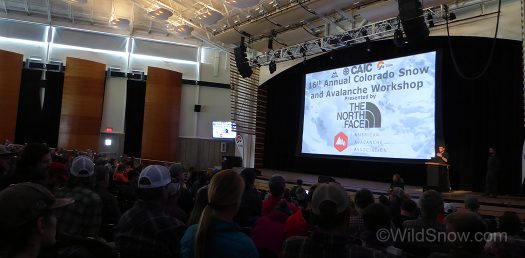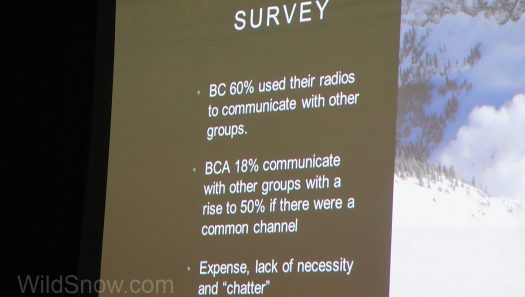Before we begin… Backcountry Access might actually have more 2-way radio content than we do! Check them out.
Throw away your snowpit thermometers! Include the Taliban in your hazard assessment! Rational choices versus naturalistic decision making process!
Well, the first two presentations were fun. I learned something. As for rational choices, otherwise known as decisions, that one went way over my head. But I figure no one person can understand all the avalanche experts — all of the time.
Yes, attending CSAW (Colorado Snow and Avalanche Workshop) a few days ago was interesting as always.
The event goes for a day, with a dozen presentations. My favorite? Engineering the bomb trams at Arapahoe Basin nearly won me. But a down-to-earth talk about 2-way radio culture in the backcountry of Telluride Colorado held the most interest. I like radios, and I like being safer. Good combo.
For those of you in Colorado, I don’t need to tell the story of how Telluride resort provides ski lift access to an abundance of uncontrolled backcountry terrain. Nor do I have to go through the history of how that terrain has been the focus of private property disputes and controversy about allowing public access from a resort to avalanche terrain. We did cover some of that a while back as I found the private property issues to be interesting from a land use perspective (private vs public rights, search WildSnow for related posts). Apparently, enough of this has been resolved in recent years to make skiing Bear Creek pretty much a done deal.
Result is one of those “watch out what you pray for…you might get it” situations. Scores of skiers (if not hundreds over a few days during good conditions) dropping into prime avalanche terrain. Next to each other. Above each other. Needing to lend a hand in rescues of each other. And so on. All scenarios subject to the adage that more communication equals enhanced safety. Begging the question: is shouting an effective form of safety communication in avalanche terrain — especially between various groups? Clearly, no.
Thus, in a perfect storm of technology and need, the use of FRS/GMRS radios came into play here in a big way, a positive development that should be an example for other heavily used backcountry zones. A non-profit, Telluride Mountain Club, has played a big part in this. They’ve spearheaded the standardization of radio “channels” and done a good job of communication via their website.
According to presenter Matt Steen (heli ski guide and avalanche forecaster), the use of radios by skiers in Bear Creek has gone upwards of 50%. He offered that taking communication to this level produces a huge increase in safety, not only for your own group, but for the community as a whole when numerous skiers share a zone. I’d enthusiastically agree.
Matt brought up a couple of radio use issues identified in an opinion survey of Telluride backcountry skiers.
“Too much chatter” on common “Group Monitoring” frequencies is in my opinion the most difficult to handle. Problem is, professionals are usually trained on radio protocols such as keeping transmissions short and subject specific, while the general public tends to use 2-ways more as if they’re chatting on a cell phone. Education and awareness are keys for this, as well as technological tweaks such as only having one person in a group monitoring the common channels (perhaps with a radio with features such as “dual watch” or configurable scanning that allow them to receive on two different channels).
Cost of radios was another pain point identified by Matt. That’s clearly solvable. While the BCA Link is obviously the rig for the job (made for snowsports, waterproof, high quality, dedicated speaker-mic with external channel selection), a skier on a budget can obtain a variety of FRS/GMRS radios for less money. While most budget rigs are not waterproof and require an add-on speaker mic, they’ll get you into the communication game.
(This is where I mention that BCA Link radios are available to Telluride Mtn Club members at substantial discount — perhaps you can arrange something similar with your own local retailers).
Another pain point in this, I’m all too familiar with, is what I’d call “technology overload.” Like many of you, I want my smartphone to do everything. Instead, I still find myself carrying a camera, GPS, 2-way radio, and yes, my phone. It’s sometimes all too much. More, radios add significant weight to a minimalist kit, and the controls can be less than intuitive.
By way of examples: It is not not uncommon for an HT (radio, handheld transmitter, handy-talkie) to lack a volume control, instead requiring you to jump through settings on the LCD screen to get the thing loud enough, or less than ear damaging (BCA Link thankfully has volume control on the speaker mic, sported outside your clothing). Also, for a reason that remains unknown to this day, many manufacturers choose to install a variety of maddening beeps and rings, all enabled by default. There’s almost always a way to turn those stupid “features” OFF, but digging through the menus is required. Most radios have a keypad lock that prevents accidental settings changes, memorize and use!
Matt also alluded to using effective language in radio communication. In his words, “Use plain English.” I’ll embellish that. Avoid 10 codes and cryptic slang. Remember to speak a split second _after_ you push the transmit button (doing so allows time for receiving radios to “open up” for your privacy code and keeps a quick finger from chopping your first word in half.) In terms of plain English, I advocate using the words “affirmative” and “negative” instead of yes, yeah, no, nah, etcetera. During a poorly received transmission, the longer words will remain much more legible.
If you want to get fancy, there’s a reason you’ll hear experienced operators do things such as shortening “affirmative” to “a-firm,” two syllables as opposed to three for the word “negative,” thus perhaps easier to differentiate. Many other considerations as well, this PDF from BCA gives an excellent overview.
Cliches to avoid, that make you sound silly and clutter up the airways:
— Redundant use of “10-4,” combined with other words that mean “ok, fine”
— “over and out,”
— “2,3,1,dropping.”
Beyond cliches, it is sometimes useful to incorporate a closing statement into your transmissions — especially when a larger number of people are using the same channel. Sometimes I prefer to simply say “over” when I’m done talking, meaning I’m turning the radio channel/frequency “over” to everyone else. Don’t get carried away with this, doing so sounds silly and is just an extra word, stopping your talk usually suffices.
Give some thought to directions as well. In the heat of the moment, not a few observers have screamed into their radio “GO RIGHT” when they actually meant for the skier to turn to her left, away from that enormous avalanche.
Perhaps you’re visiting Telluride or want to start your own local radio comm initiative. Below are the BCA Link channels and FRS frequencies published by Telluride Mountain Club. The BCA channels are preset in the BC Link radio, thus keeping it nice and simple for folks who don’t want to nerd out on technology. But you can set any consumer type “blister pack” FRS or GMRS radio to these frequencies (aka channels).
— Lower Bear Creek: FRS channel 1 with privacy code 0 – Channel A on BC Link.
— Upper Bear Creek: FRS channel 5 with code 10 – Channel B
— Wasatch: FRS channel 4 with code 20 – Channel C
— Ophir: FRS channel 8 with code 10 – Channel D
— Rescue Channel (for public use when a rescue is underway, official SAR will use their own non-public frequencies as well): 9-11 – Channel E
— BC Link channel F is set to FRS channel 20, privacy code off.
Oh, and by the way, my biggest takeaway from CSAW? If you’re talking to the US Forest Service, don’t call it a “bomb tram.” It’s an EDS or something like that. Anyone care to accurize my acronym?
Additional Reading
Human factors and radio use, from BCA
Our main 2-way radios article, curated and updated
WildSnow extended BC-Link radio review.
WildSnow.com publisher emeritus and founder Lou (Louis Dawson) has a 50+ years career in climbing, backcountry skiing and ski mountaineering. He was the first person in history to ski down all 54 Colorado 14,000-foot peaks, has authored numerous books about about backcountry skiing, and has skied from the summit of Denali in Alaska, North America’s highest mountain.


